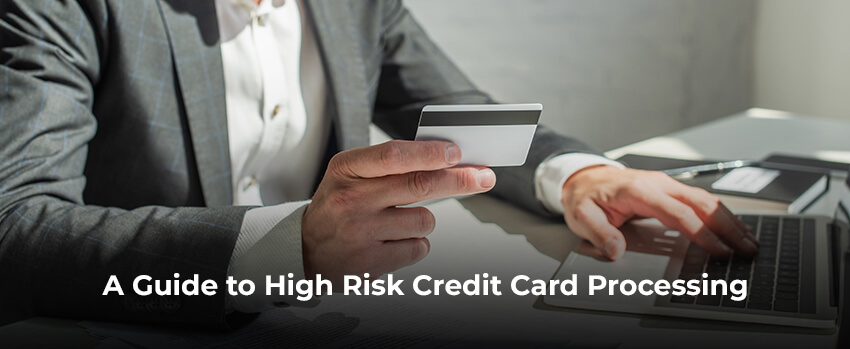A Guide to High Risk Credit Card Processing
A Guide to High Risk Credit Card Processing

In this world of payments, there’s one key buzzword that no business asks to think about but must always think about: risk. This hot topic has covered the way for a completely new industry: high risk credit card processing.
For any high-risk business, protecting a merchant account through a traditional processor can be very tough. Risk is never a word that banks will hold, which means there is always going to be an extra path to travel through in return to get sanctioned for a high-risk merchant account. Happily, there are ways to neglect these pitfalls and simultaneously work on the growth of the company.
The correct payment partnership assists you manage this process on your terms. Contrasting traditional retailers who can get a merchant account in the first go, those who involve in the sale of merchandise considered “risky” can be harder to get their place in the orthodox financial fold. It is said higher the risk, the more problems to overcome. Fortunately, there is a smooth path for business owners to take to get sanctioned for a high-risk merchant account, continue their account, and start inflating their business.
To know completely how to direct the challenging high risk credit card processing system, merchants must first acknowledge what defines this industry, how they can regulate why they’re called high risk, and what they can do to control this process without convoluting their payment processing requirements.
The Shades of High Risk Credit Card Processing
Traditionally, being labeled “high risk” would be an ending-all for a merchant. The nomination of requiring high risk credit card processing services, nevertheless, doesn’t have to take the same negative implication. Like mostly everything in this world of payments, this subject isn’t so under the shade that there can be advantages to plunging into the high risk credit card processing group.
For a merchant to receive credit card payments, they have to secure a merchant account along with acquiring a bank. The cost of having this service differs based on what bank you select, what sort of business you have, and the extent of transactions you’re directing regularly. It all falls on how much risk there is correlated with the sort of products you are vending.
In general, the term “high risk” refers to services connected with a variety of services that might have more fraud indulged with them. This may in cooperate things like gambling services, telemarketing, pharmaceuticals, travel, legal services, dating services, computer software, CBD and Hemp oil dealers, credit repair services, electronics, financial investment services, and goods that are more likely to have a high risk for being forged. That risk may look lengthy and broad, but there is a common connection linking between each of them: The common alliance to illegal behavior and the inclination to fraud.
For that main factor, the fees in cooperating with high risk credit card processing generally fall on the higher side. These merchants should be well equipped to handle these sorts of transactions. Many old processors won’t take on these sorts of goods and services because of the related risks, which is why the world of high risk credit card processing still survives. Every business has to process credit cards, anyhow of the recognized risk, which is why this is a market of its own.
A high-risk status is normally allocated to businesses who might vend expensive merchandise in these segment or has high monthly sales. The nature of the products and services is also related to more chargebacks since there is a high chance for transaction disputes to happen. This can open up risks for banks and credit card processors, as well as the merchants themselves, which is why there is a segment of high risk credit card processing companies come into this market.
What Defines a High-Risk Credit Card Processing Merchant?
However, the products and services sold by merchants in the “high-risk” segment are generally legal business deals, banks and credit cards purely don’t like the connected fame. As they are often on the hook when a transaction is discussed, many banks aren’t anxious to take on merchants associated with high risk credit card processing. Since products and services in this group are commonly particularly controlled, they elevate more regulatory red flags.
The best way to get better this hurdle is by looking for a payment processing partner that has already tried his hands in this market and has well-settled terms with financial institutions who are interested to trust the mediator’s payment processor to take on much of the risk related with these transactions. Give a thought on a high risk credit card processing supplier as the middle-man between the merchant and the bank to make a more reliable relationship.
Email us anytime!
Email customer service 24/7 at info@binarygateways.com
![]()
Call us anytime!
Reach customer care 24/7 at (801) 761-5001
There are many factors for a merchant who lands on the high-risk list. One of the most general factors is that the merchant is contributing products or services that are anciently liable to a heavy amount of chargebacks. Merchants who receive recurring payments often jump into this group since these types of transactions are more likely to be debated by consumers — both for legal or ill legal reasons. It could also directly be that they are a new merchant that doesn’t have a demonstrated record of solid credit card processing history. Bad credit history is one more way to categorize this list.
Where and how you behave payments and process payments is also a major reason. Merchants who receive multiple payments and sell merchandise away from the U.S. can generate a red flag to banks and processors who are scanning to neglect to take on high-risk merchants. There is more probability to be a fraud when transacting with many currencies, especially when conducting business cross-border — especially outside regions like the U.S., Western/Northern Europe, Australia Japan, or Canada.
What Merchants Can Do to Supervise High-Risk Credit Card Processing
For merchants who come under the segment of high-risk credit card processing, the first thing they need to understand is what thought comes when an underwriter goes through an application for a merchant account. Like any financial partnership, the underwriter is aimed at avoiding a large volume of unpaid chargebacks and limiting exposure to regulatory fines from the government or card brands.
Some methods can help merchants avoid pitfalls. To start, when dealing with high-risk credit card processing, it’s always good to have some funds in your bank account to show stability. You’ll want to prove you’re a legitimate business and be transparent about what goods or products you are selling. Beyond those key financial checks, you’ll want to ensure your website follows basic security protocols, such as having a secure license (SSL), and that you’re properly marketing your business model. This means being transparent to customers about terms and conditions for buying products/services and how your shipping and return process works.
The last bit of information merchants must consider is the amount of processing volume allowed. In high-risk credit card processing, this process gets a little more complicated. For example, your business may be able to take in a large amount of revenue each month, but that doesn’t mean the underwriter is willing to approve that amount or take on the risk. The trick here is to provide the underwriter with as much information as possible to ensure the underwriter is confident in taking on your business.
Unfortunately, the only way to convince many underwriters is by proving your stability over time. Traditionally, a 3 to 6-month period of successful payment processing without large amounts of chargebacks will help the underwriter increase your approved processing volume. Having consistent transaction sizes can also help your business establish some regularity, which may trigger an underwriter to re-review your monthly processing volume limit.
The perfect way for managing your high-risk merchant accounts is to expand your business model. For example, if your business is offering subscription-based products or services or recurring payment choices, this certainly makes you fall into the high-risk credit card processing category. Neglect extra inspection by adding other payment methods such as ACH. For businesses needing to lower transaction fees, get payments quicker, and make the process painless for you and your customers, ACH can send a more streamlined way to get continuous recurring payments approved.
Some Related Blogs:
A Brief Guide On How To Integrated Processing
Welcome Your New Year With New Business ideas
Credit Card Payment Acceptance Without Merchant Account
Merchants You Can Avoid Chargebacks Occurring From High-Risk Credit Card Processing
High-risk merchants suffer from the major problem that is more chargebacks. Thankfully, there are methods to retain your chargebacks under power so you don’t damage your terms with your high-risk processor or the acquiring bank. The major move here is depending on a third-party chargeback prevention platform that can observe your merchant account in real-time in advance to help you in managing the process.
Chargebacks are a major pain for any merchant, but they don’t have to be so intricate. With the correct partner, your business can be private to a solution that generates the chargeback monitoring process so you can don’t worry about your transactions and concentrate more on inflating your business. The correct chargeback partner can give a clear path so that you can get ahead of any chargeback difficulties and be there to get back the lost income whenever a chargeback does get filed.
With all the present technology in the marketplace today, your business shouldn’t be left behind. The right chargeback prevention partner will allow you real-time transaction observation of your merchant account, providing business-friendly analytics, and beg enough time and money for you so that you can do your best: Increase your business and make your customers happy and satisfied.
Like there are many things in the payments industry, there’s always a partner equipped and ready to deliver your business the solution on the very spot to overcome any pitfall — even for those asking for high-risk credit card processing. Once that partnership is discovered, you can better look around for the chargebacks, fight against fraud, and fully secure your business.
